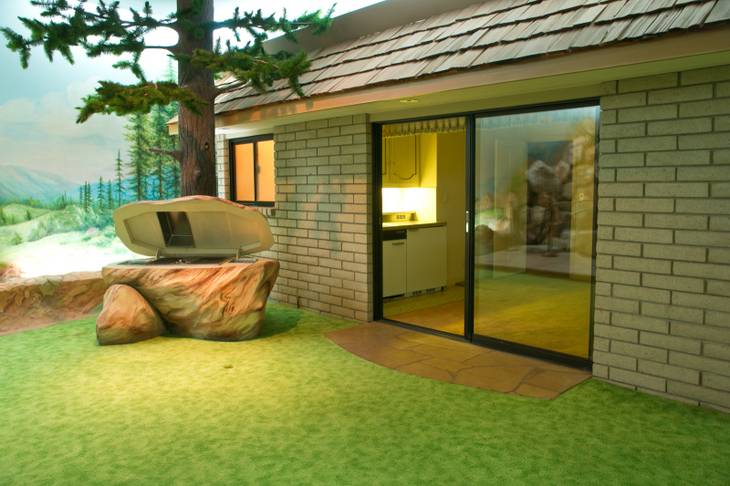At a sprawling home for sale near Flamingo Road, you can golf, barbecue, swim, relax in a hot tub, dance under a starry sky and make breakfast while gazing at the mountains.
All while 26 feet underground.
The two-bedroom, three-bathroom house at 3970 Spencer St. might be the most peculiar in Las Vegas. It is buried 26 feet underground, underneath a typical suburban two-story house.
A few miles east of the Strip, it was built in the 1970s to give people a place to safely retreat if the Soviets wiped out humanity with a nuclear missile strike.
And despite its unchanged “Brady Bunch” decor, the home fits right in with 21st century Las Vegas: It now is bank-owned.
Seaway Bank and Trust Co. foreclosed on the house last summer. The previous owner bought the home and the two-story house above it in 2005 for $2 million, according to Clark County records.
Seaway, based in Chicago, now wants to sell it for $1.7 million.
About a dozen prospective buyers have toured the site since last summer, including one man who flew in from Hawaii just to see it. He wanted to buy it with other investors and make it a paid tourist attraction.
“I don’t think his partners went for it,” said listing agent Winston King, of Kingly Properties.
The home, which spans more than 5,000 square feet, is part of a 15,200-square-foot basement that also features a casita. Above ground, the only clues of what lies below are large ventilation units, air conditioners and two emergency exits scattered around a property. One of the exits looks like a cave, the other a shed.
The underground refuge seems designed to stave off boredom and claustrophobia.
It has a four-hole putting green, a swimming pool, two jacuzzis, a sauna, a dance floor with a small stage, a bar, a barbecue and huge murals of rural, tranquil settings.
The house also has a laundry room, a full kitchen, a fireplace, a generator, fake trees, fake flowers, two elevators, fire alarm bells, smoke detectors, an intercom system and several large pantries. Light switches labeled “Sunset,” “Day,” “Dusk” and “Night” mimic those settings by dimming or brightening lights and stars on the ceiling, which is painted sky blue with white clouds.
“Makes you feel at home, outdoorsy,” King said.
The place is a time capsule, with ’70s-era appliances, pink kitchen trim, green carpet for “grass,” and pink carpet, walls and drapes in the master bedroom and bathroom. Even the toilet is pink.
“There’s not much you need to change anywhere,” King said. “It’s just kind of perfect the way it is.”
The original owner, entrepreneur Girard B. “Jerry” Henderson, feared a nuclear Armageddon during the Cold War. While others built fallout shelters, he wanted to live underground full time, according to news reports.
In the mid-1960s, he built and lived in a similar home on a 320-acre mountain property near Boulder, Colo. It had four bedrooms, a swimming pool and a helicopter pad “for quick getaways,” according to Henderson's family genealogy website.
Ever the businessman, Henderson also co-founded Underground World Home Corp., a subterranean home building company. A brochure on Flickr boasts that underground living is healthier, cleaner, quieter, cheaper, safer and is “the ultimate in true privacy!”
“How would you like sunshine every day ... when you want it?” the brochure asks.
The Hendersons built the Las Vegas home in 1971, according to the family biography. Jerry died in Las Vegas in 1983, followed by his wife, Mary, in 1988. A relative, Tex Edmondson, acquired the property in 1990. A buyer in Chicago picked it up in 2005 but lost it to foreclosure last June.
Robert Fielden, a longtime valley architect, said he doesn’t know of any other bomb-shelter homes locally. Throughout the country, though, some people have turned old missile silos into homes, he said.
Fielden described the house as “creepy” but wouldn't rule out the possibility of someone buying it.
“It’s probably worth it,” he said of the asking price, “if you like living underground.”

